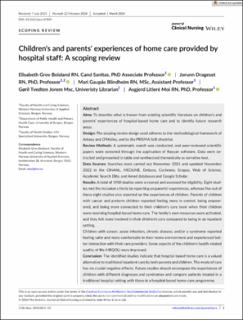| dc.description.abstract | Aims: To describe what is known from existing scientific literature on children's and parents’ experiences of hospital- based home care and to identify future research areas.
Design: The scoping review design used adheres to the methodological framework of Arksey and O'Malley, and to the PRISMA-ScR checklist.
Review Methods: A systematic search was conducted, and peer- reviewed scientific papers were screened through the application of Rayyan software. Data were extracted and presented in table and synthesised thematically as narrative text.
Data Sources: Searches were carried out November 2021 and updated November 2022 in the CINAHL, MEDLINE, Embase, Cochrane, Scopus, Web of Science, Academic Search Elite, and Amed databases and Google Scholar.
Results: A total of 1950 studies were screened and assessed for eligibility. Eight studies met the inclusion criteria by reporting on parents' experiences, whereas five out of these eight studies also reported on the experiences of children. Parents of children with cancer and preterm children reported feeling more in control, being empowered, and being more connected to their children's care team when their children were receiving hospital- based home care. The family's own resources were activated, and they felt more involved in their children's care compared to being in an inpatient setting. Children with cancer, acute infection, chronic disease, and/or a syndrome reported feeling safer and more comfortable in their home environment and experienced better interaction with their care providers. Some aspects of the children's health- related quality of life (HRQOL) were improved.
Conclusion: The identified studies indicate that hospital-based home care is a valued alternative to traditional inpatient care by both parents and children. The mode of care has no crucial negative effects. Future studies should encompass the experiences of children with different diagnoses and syndromes and compare patients treated in a traditional hospital setting with those in a hospital- based home-care programme.
Relevance to Clinical Practice: Children's and parents’ experiences of HBHC indicate that it offers a good solution if parents are well prepared and feel in control. In addition, certain structural conditions must be in place before this type of care can be established: there must be a certain number of patients and the hospital must not be too far away. In the field of neonatal home care, professionals should be more responsive to fathers’ needs and tailor support by focusing on their individual experiences and needs. Our findings may guide and inform best practice for present and future providers of HBHC.
Implications for the Profession and/or Patient Care: Hospital- based home care can offer families a greater degree of autonomy, more flexible care options, improved family functioning, improved communication with care providers, and more control over the child's care. When certain structural conditions are met, such as a certain number of patients, the hospital not being too far away, and parents being well pre-pared and feeling in control, then hospital- based home care is valued as an alternative to traditional inpatient care. Specific aspects of children's HRQOL may improve, and the psychosocial burden on the family does not increase.
Impact: HBHC provides a valued alternative to traditional inpatient care and allows families to receive care in the comfort of their own home. Our findings may guide and inform best practice for present and future providers of hospital- based home care.
Reporting Method: In this scoping review, we have adhered to the Preferred Reporti | en_US |

